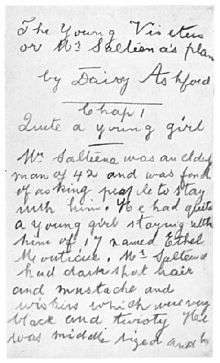The Young Visiters
 First page of The Young Visiters manuscript | |
| Author | Daisy Ashford |
|---|---|
| Country | United Kingdom |
| Language | English |
Publication date | 1919 |
| ISBN | 0-89733-365-9 |
The Young Visiters or Mister Salteena's Plan is a 1919 novel by English writer Daisy Ashford (b1881). It was originally written by her when she was nine years old and part of its appeal was its juvenile innocence , and un conventional grammar and spelling. It was reprinted 18 times in its first year alone.
Plot
Alfred Salteena, an "elderly man of 42", has invited 17-year-old Ethel Monticue to stay with him. They receive an invitation to visit Alfred's friend, Bernard Clark, which they readily accept. Bernard is "inclined to be rich" and shortly after their arrival, Ethel and Bernard are already attracted to each other.
Alfred seeks Bernard's advice on how to become a gentleman. Bernard is doubtful that this can be managed, but writes an introduction to his friend, the Earl of Clincham. Alfred excitedly rushes off to London to visit the Earl, leaving Ethel alone (and unchaperoned) with Bernard.
Lord Clincham lives, as do many other aristocrats, in "compartements" at the Crystal Palace. He agrees to assist Alfred and installs him in a subterranean "compartement", along with other "apprentice gentlemen". He invites Alfred to accompany him to a reception hosted by the Prince of Wales (the future King Edward VII), introducing Salteena as Lord Hyssops. The Prince is impressed and promises to assist the trembling and overjoyed Salteena.
Bernard and Ethel are in love and marry. Devastated by these events, Salteena marries a maid-in-waiting at Buckingham Palace. Lord Clincham also marries, but not very happily.
Composition and publication
Ashford wrote the novel at the age of nine, in 1890, in an exercise book. Full of spelling mistakes, each chapter was also written as a single paragraph. Many years later, in 1917 and aged 36, Ashford rediscovered her manuscript languishing in a drawer, and lent it to Margaret Mackenzie, a friend who was recovering from influenza. It passed through several other hands, before arriving with Frank Swinnerton, a novelist who was also a reader for the publishing house of Chatto and Windus. Largely due to Swinnerton's enthusiasm for this piece of juvenilia, the book was published almost exactly as it had been written. J. M. Barrie, the creator of Peter Pan, agreed to write a preface.
Reception
The book was so successful that it was reprinted 18 times in its first year alone. After its publication, rumours soon started that the book was in fact an elaborate literary hoax, and that it had been written by J. M. Barrie himself. These rumours persisted for years.
Adaptations
A stage play of The Young Visiters by Mrs George Norman and Margaret Mackenzie was first performed in London in 1920, transferring shortly thereafter to New York. The New York production, at the Thirty-Ninth Street Theatre, received generally good reviews; one reviewer stated:
"The Young Visiters" ... has been turned into a play by the simple use of a pair of shears and a pot of paste. Probably no novel was ever so reverently dramatized since the world began.[1]
A musical based on the book by Michael Ashton and Ian Kellam was produced in 1968,[2] a feature-length film of The Young Visiters was made in 1984 starring Tracey Ullman and John Standing, and a television film version of The Young Visiters was made by the BBC in 2003, starring Jim Broadbent as Alfred Salteena, Lyndsey Marshal as Ethel Monticue and Hugh Laurie as Lord Bernard Clark. The screenplay was written by Patrick Barlow and it was directed by David Yates.
The original manuscript of The Young Visiters is held in the Berg Collection of New York Public Library.[3]
Citations
Evelyn Waugh mentions the book in his novel A Handful of Dust as part of the childhood reading of his hero Tony Last.
The critic Edmund Wilson referred to the novel This Side of Paradise by his friend F. Scott Fitzgerald as "a classic in a class with The Young Visiters." , meaning it had a rather naive style. [4]
References
- ↑ Woollcott, Alexander (30 November 1920). "THE PLAY; Miss Ashford's Play" (PDF). The New York Times.
- ↑ Lorna Sage; Germaine Greer; Elaine Showalter (1999). The Cambridge Guide to Women's Writing in English. Cambridge University Press. p. 22. Retrieved 11 November 2008.
- ↑ "A Note on the text" in a 1989 edition of the book, Chatto & Windus, London ISBN 0-7011-2725-2
- ↑ Mizener, Arthur (1965). The far side of paradise: a biography of F. Scott Fitzgerald, p. 369
External links
| Wikisource has original text related to this article: |
- Works by Daisy Ashford at Internet Archive. Scanned original edition books.
- The Young Visiters, at Project Gutenberg. Plain text and HTML formats.
- "Daisy Ashford a Very Real Young Lady", 31 August 1919, The New York Times Book Review, Page 74
- TV adaptation on IMDb
- The Young Visiters at the Stone Soup archive.